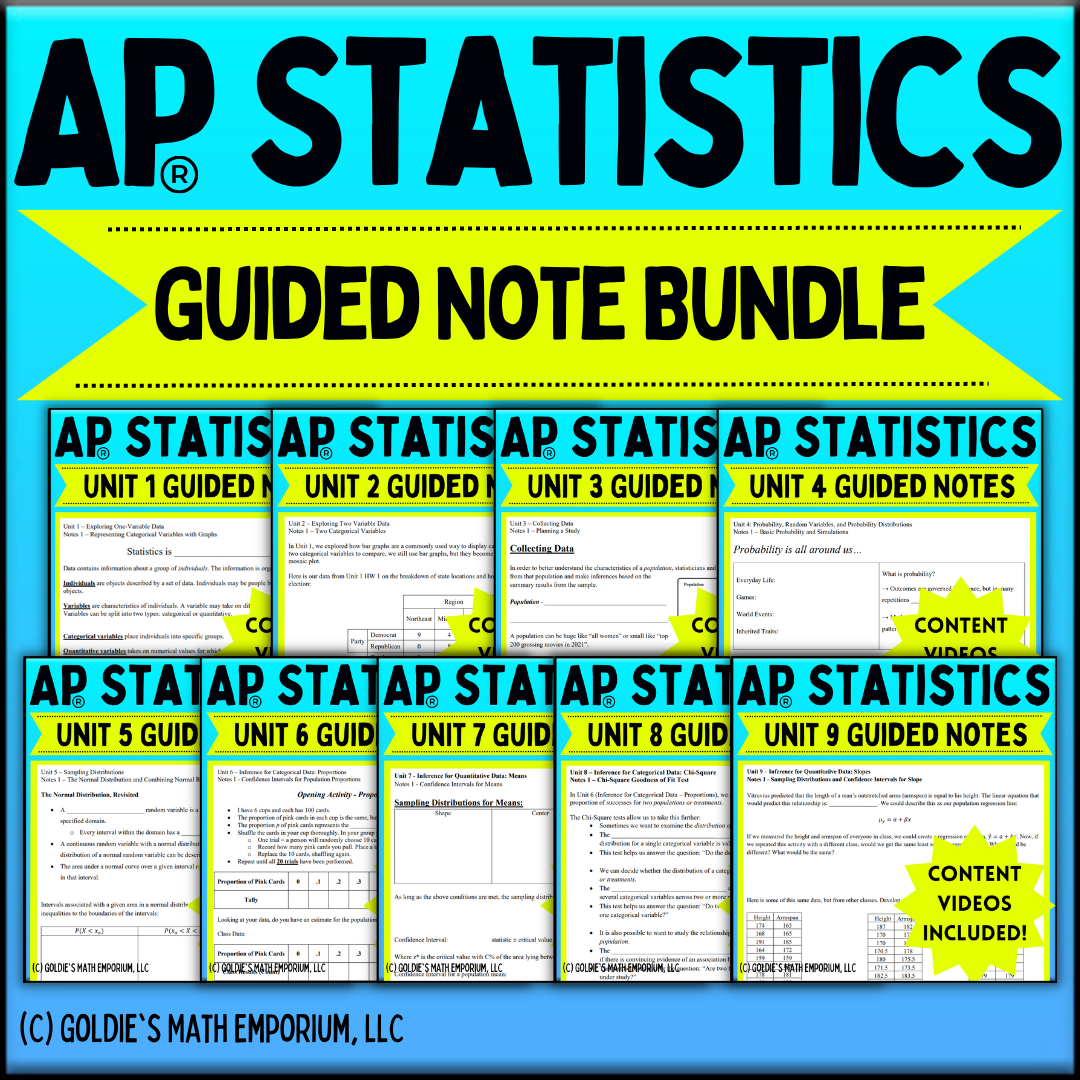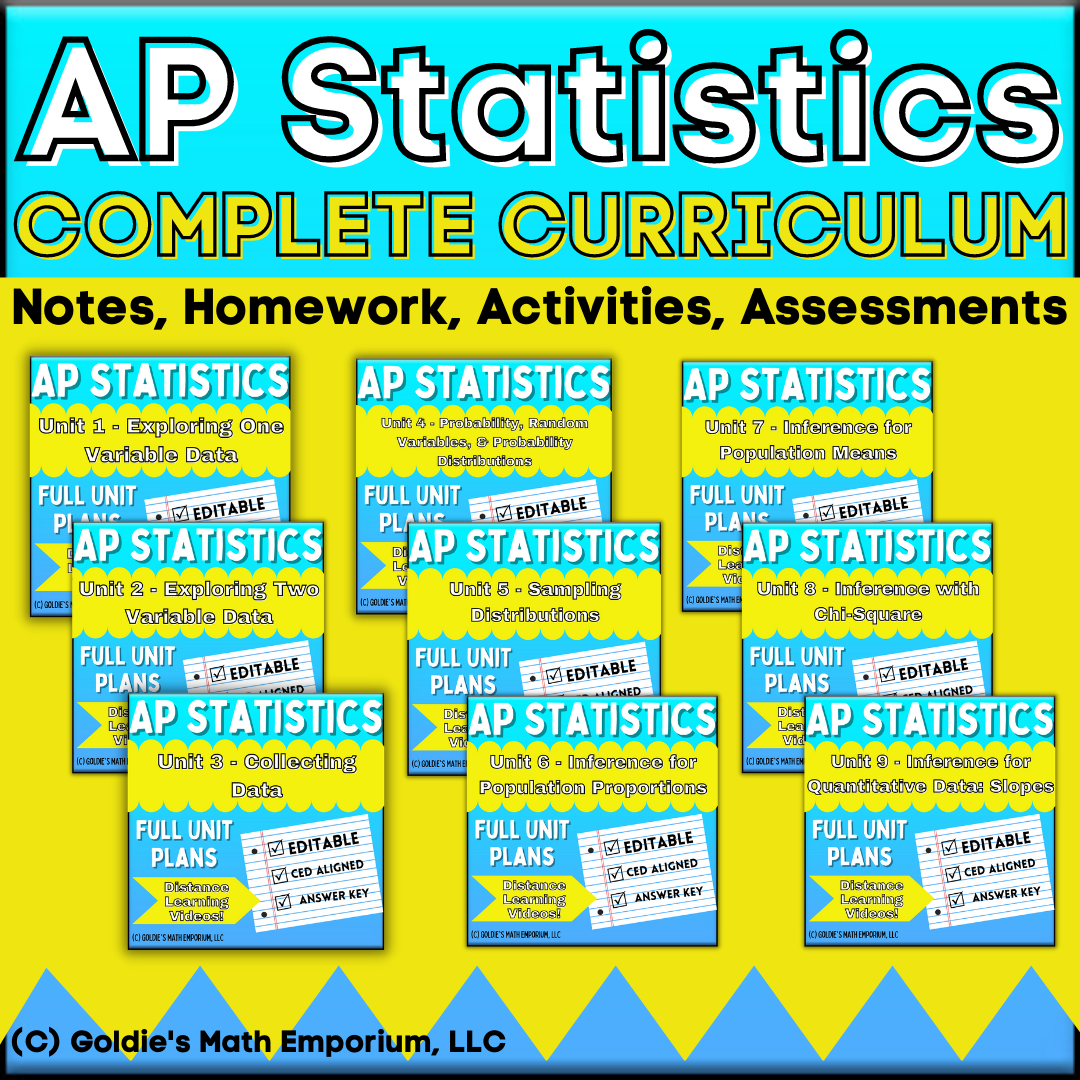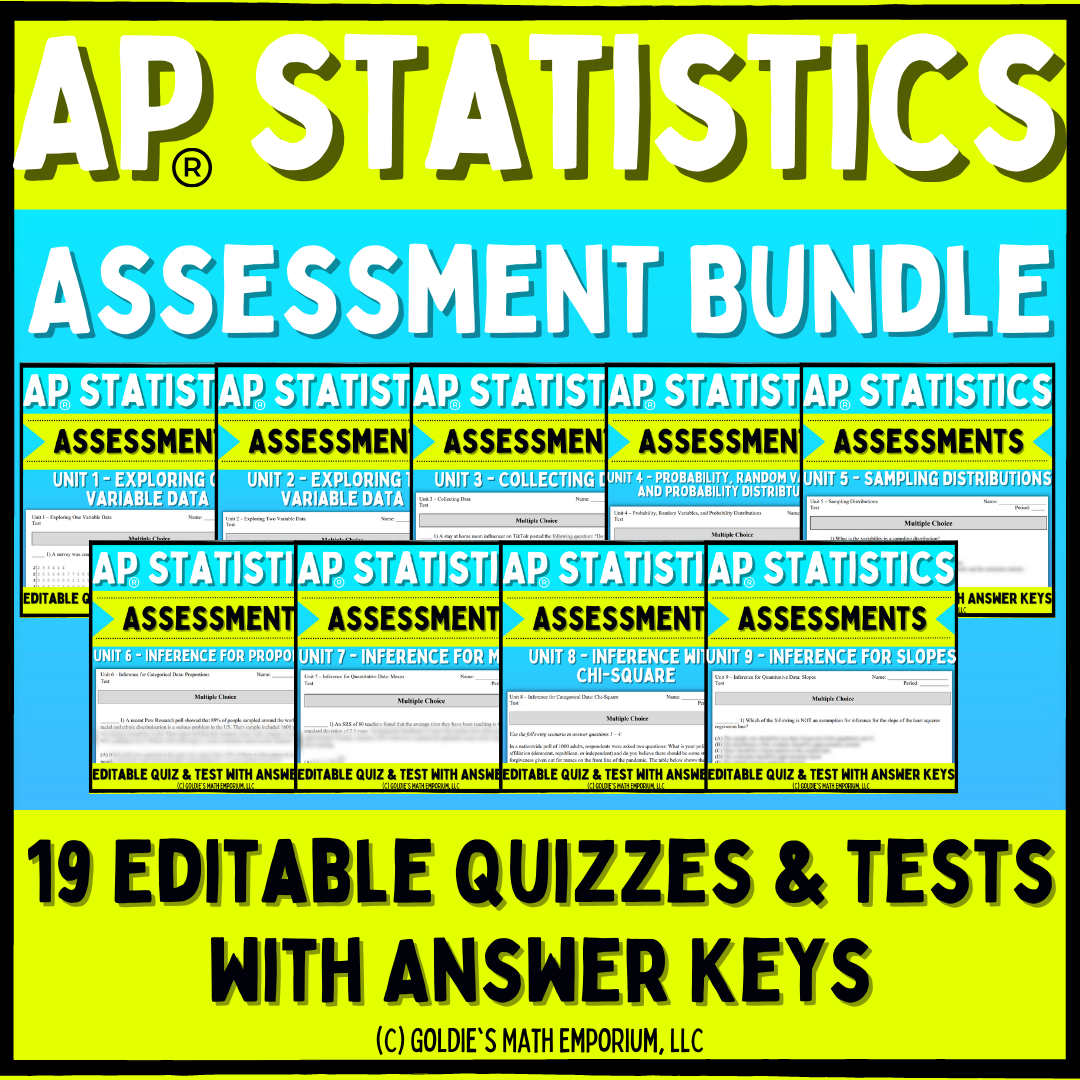Welcome all! Here, let’s discuss what this unit looks like in my classroom. I’m hoping this blog post will help you start planning out your own probability unit in your AP Statistics classrooms. Keep reading to see how I balance pacing, summary days, and hands-on learning in Unit 4.
Disclaimer: I am a classroom teacher of 10 years. All the commentary in this post is based on my personal experience; please do not think you must teach Unit 4 this way, or that this is the absolute best practice in the classroom. This is what has worked for my students and pulled very successful exam scores through the years.

Unit 4 – Almost 4 weeks?
The AP© Stat CED recommends spending 18 – 20 days on this unit. I laid out everything in the pacing guide so that this unit is completed in 19 days (check out my FREE pacing guide at the end of the blog!). We know that timing is always tight right as we get to Unit 4, so I do have some suggestions under “Questions on Timing” below that could help you!
Notes
This year, I rearranged my notes so that I’m doing smaller lessons (25-40 minutes) and then giving a homework assignment for students to practice material. Here is how I layout my notes:
Notes 1 – Basic Probability and Simulations
Notes 2 – The Addition Rule
Notes 3 – Venn Diagrams, Unions, and Intersections
Notes 4 – The Multiplication Rule and Conditional Probability
Notes 5 – Discrete and Continuous Random Variables
Notes 6 – Combining Random Variables
Notes 7 – The Binomial Distribution
Notes 8 – The Geometric Distribution
As always, there are videos of me teaching these materials that go along with each set of notes. I’ve found these videos to be SO HELPFUL for students who miss class, or if I am ever absent a few days during the unit.
I still really enjoy giving out the note packets at the beginning of the unit for the students. If they are ever absent, if I am, or if our copier is just broken (let’s be honest, that happens ALL. THE. TIME.), it is nice to still have all the notes printed and not have to worry about them.
Summary Days
By now, you’ve seen that I love a good review day. My students have always said that they love having a day where I summarize the major points in the unit, and then give them time to work through problems and ask their questions.
I have two teacher-lead review days in this unit. There are slides for you to flip through that show the answers to a student handout summarizing the main points. My students LOVE these days, but I know some teachers prefer to have the students be more hands-on these days instead. It is all about what you feel comfortable doing with YOUR students. The third review day (Unit 4 test review day), I do not have any teacher-lead slides. We usually use this day to go over most missed problems from the random variables quiz, and then I give them the rest of the day to start working on the test review and ask questions.
Question on Timing
When I plan for the year, I always want to get through Unit 4 by the time semester 1 exams roll around. I try to finish Unit 4 with enough time for a couple of days of cumulative review before the semester 1 final.
I’ve been pretty good at doing this the past few years. Sometimes, I have to cut out an activity or two in Unit 4 to make sure I make it, but I usually do. This was not the case at the beginning of my teaching journey!
Before the CED was published, I was lucky to get through conditional probability by the end of the year. All my random variable material was saved for second semester. Now doing this was not impossible, but I barely had time to teach Unit 9 (we are talking, a single class period to go over Unit 9), and I had only about 2 weeks for review, but it was possible!
It also depends on when your school year starts too. We start mid-August in my area, so finishing Unit 4 by winter break is doable. If you don’t start until mid-September, this might be more of a challenge. If you are stressed about time in Unit 4, here are some things that you can do to make sure you get through the material comfortably:
- Make the two quizzes take-home (or get rid of them all together) – this will free up two days for you!
- Make the quizzes shorter, so that you use the review slides for half the period and the shorter quiz for the second half of the period
- The first activity I would cut out would be the binomial distribution of blue (an M&M activity). While I love getting students hands-on with the binomial distribution, this is not necessary to complete the content, but instead is there to help reinforce it. Don’t feel guilty for skipping it.
- You might not also need a full day for the Unit 4 project. I like taking a day to introduce it and then giving students time to work on it. If you are pressed for time, you do not have to use this day for a project.
Probability Activities
When I started teaching probability, I really struggled with the “hands-on” part of learning probability. It was hard for me to step away from the lecture-practice-assess model, since that was my comfort zone (especially with probability, which I was originally so uncomfortable with!).
I finally have reached a point where I feel really good about the activities my students are doing in this Unit. It breaks up the lecture-practice-assess atmosphere and lets them work with each other on the topics we talk about in class. Here is a brief description of each activity and when I use them:
Introduction to Probability Activity
- This is an activity I do before we start notes for the Unit. I introduce a game called “beat the teacher” and you run through a simulation with the students to see if it is a fair game to play. Students are introduced to the basic probability formula, as well as empirical and theoretical probability terms.
Unit 4 Circuit
- This is a review worksheet in a “circuit style” review. Students work through 14 problems on basic probability rules and conditional probability.
Simulations Activity
- This activity allows students to practice the four-step process while performing 3 simulations.
Simulations and the Binomial
- Students explore conducting a simulation to answer a question and are met with the limitations of conducting simulations. The solution? The Binomial Random Variable!
The Binomial Distribution of Blue Activity
- Students get hands-on with M&Ms to compare the theoretical probabilities obtained with the binomial formulas to the empirical probabilities obtained in a bag of M&Ms.
Make Your Own Casino
- Students create 3 games of chance to practice developing a probability distribution: one where the player wins, the house wins, and one where the game breaks even. (Example report and rubric included)
Introduction to the Binomial
- Students will take a quiz in Chinese (to simulate randomly guessing T/F on a quiz), find the probabilities of getting the questions correct, and then see how we can fit a probability distribution (aka, the binomial) to the data.
I also have two additional lessons in my projects and activities package. These lessons are ones I teach in my regular-level statistics course and ones that I use to teach in AP Statistics before the CED redesign in 2020. The content is not included on the AP exam anymore, but they are very closely related to what we are learning about in class:
Permutations and Combinations Lesson
- This is an additional lesson you can use to teach the counting principle, combinations, and permutations. There is a set of notes and a homework assignment.
The Poisson Distribution Lesson
- This is an additional lesson you can use to teach about the Poisson Distribution. There is a set of notes and a homework assignment.
TL;DR
If you have made it this far in my blog post, thank you! I really hope that some of the things I have gone over can help you in your classroom. Check out my freebies for this unit below and as always, feel free to email me any time with any questions.









0 Comments